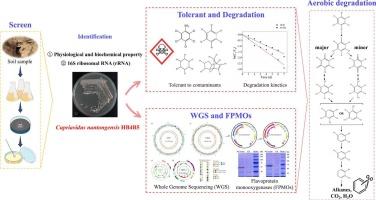nantongensis Cupriavidus HB4B5对六氯苯和五氯硝苯的好氧降解:脱氯机制和生物修复潜力
IF 9.7
1区 环境科学与生态学
Q1 ENVIRONMENTAL SCIENCES
引用次数: 0
摘要
包括六氯苯(HCB)和五氯硝基苯(PCNB)在内的有机氯农药(ocp)是剧毒和持久性污染物,对生态和人类健康构成重大风险。它们的化学稳定性使它们特别能抵抗生物降解。在这项研究中,我们分离并表征了一种新型的好氧细菌Cupriavidus nantongensis HB4B5,它能够有效地降解HCB和PCNB,而不会积累有毒中间体。该菌株对多种ocp (HCB、PCNB、六氯环己烷和氯丹)具有较高的耐受性,并将其作为碳源。在7 天内,菌株HB4B5对HCB和PCNB的降解率分别达到91.74 %和79.75 %。全基因组测序结果显示,HB4B5不仅可以通过好氧脱氯降解多取代氯苯,而且还具有降解其他芳香族污染物的遗传标记,从而确立了其作为污染位点生物修复候选物质的潜力。值得注意的是,我们在功能上表征了两种黄蛋白单加氧酶(C-hcbA和C-pcpB)作为氯苯脱氯的关键催化剂。催化分析证实了它们参与六氯环己烷的降解,并揭示了一种新的元位置降解途径,可以防止有毒中间体的积累。HCB的最佳降解条件为35 °C/pH 7, PCNB的最佳降解条件为30 °C/pH 7。该研究提供了Cupriavidus物种降解HCB的第一个证据,并强调了菌株HB4B5作为一种生物修复剂对复杂氯化芳烃污染的场所的潜力。本文章由计算机程序翻译,如有差异,请以英文原文为准。


Aerobic degradation of hexachlorobenzene and pentachloronitrobenzene by Cupriavidus nantongensis HB4B5: Dechlorination mechanisms and bioremediation potential
Organochlorine pesticides (OCPs), including hexachlorobenzene (HCB) and pentachloronitrobenzene (PCNB), are highly toxic and persistent pollutants that pose significant ecological and human health risks. Their chemical stability makes them particularly resistant to biodegradation. In this study, we isolated and characterized Cupriavidus nantongensis HB4B5, a novel aerobic bacterium capable of efficiently degrading HCB and PCNB, without the accumulation of toxic intermediates. The strain demonstrated high tolerance to multiple OCPs (HCB, PCNB, hexachlorocyclohexane, and chlordane), utilizing them as carbon sources. Within 7 days, strain HB4B5 achieved degradation rates of 91.74 % for HCB and 79.75 % for PCNB. Whole genome sequencing revealed that HB4B5 not only degrades polysubstituted chlorobenzene through aerobic dechlorination but also possesses genetic markers for degrading other aromatic pollutants, establishing its potential as a bioremediation candidate for contaminated sites. Notably, we functionally characterized two flavoprotein monooxygenases (C-hcbA and C-pcpB) as key catalysts in chlorobenzene dechlorination. Catalytic assays confirmed their involvement in HCB degradation and revealed a novel meta-position degradation pathway that prevents toxic intermediate accumulation. Optimal degradation conditions were established at 35 °C/pH 7 for HCB and 30 °C/pH 7 for PCNB. This study provides the first evidence of HCB degradation by a Cupriavidus species and highlights the potential of strain HB4B5 as a bioremediation agent for sites contaminated with complex chlorinated aromatic hydrocarbons.
求助全文
通过发布文献求助,成功后即可免费获取论文全文。
去求助
来源期刊

Environment International
环境科学-环境科学
CiteScore
21.90
自引率
3.40%
发文量
734
审稿时长
2.8 months
期刊介绍:
Environmental Health publishes manuscripts focusing on critical aspects of environmental and occupational medicine, including studies in toxicology and epidemiology, to illuminate the human health implications of exposure to environmental hazards. The journal adopts an open-access model and practices open peer review.
It caters to scientists and practitioners across all environmental science domains, directly or indirectly impacting human health and well-being. With a commitment to enhancing the prevention of environmentally-related health risks, Environmental Health serves as a public health journal for the community and scientists engaged in matters of public health significance concerning the environment.
 求助内容:
求助内容: 应助结果提醒方式:
应助结果提醒方式:


